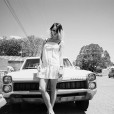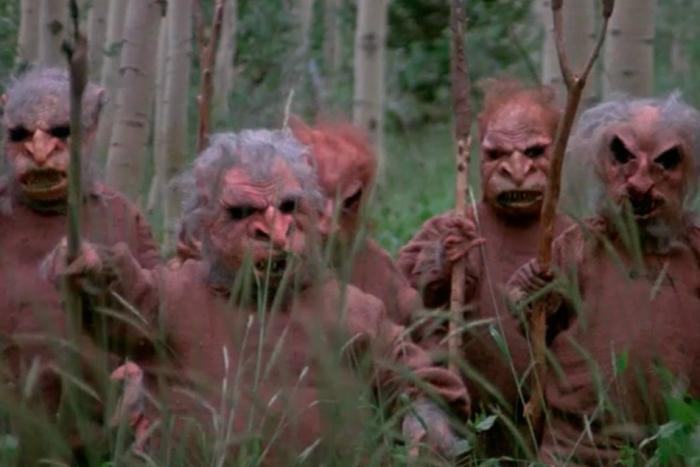This conversation originally appeared in Hazlitt #2, Summer 2014.
Most contemorary artists, and especially contemporary conceptual artists, work from a small set of axioms. Many of the best ones become famous in part for their theorems. But some—and the painter and sculptor Julia Dault is one of them—wrap a whole praxis around proofs, which both demonstrate the artist’s statements and do so in ordinary language, familiar to the eye, that admits some ambiguity in truth. Dault’s in-situ feats of duration and/or tensile strength are untitled and time stamped, ergo the most obviously mathematical. But her tricky-tacky paintings, too, are composed of subtractions done in a certain order, so that, she says, the “logic [of the colours] reveals itself.”
One of her recent canvasses is all black paint scraped in origami shapes to show fish-belly silver underneath, and when the light through a window of her Sunset Park studio falls over it, the silver turns aureate, or rose. When I went to visit her, in March, we talked long enough that I saw almost the whole of it change.
Over a twelve month period, Dault will have had three solo exhibitions: at China Art Objects in Los Angeles, which opened in April; at The Power Plant in her native Toronto, which opens this Saturday (September 20); and, next February, at Marianne Boesky Gallery, which represents her in New York. She is 36 years old. On the day I visited her, I noticed right away that we were both wearing a version of the Canadian tuxedo, but I didn’t say anything.
Julia: Hi! It’s been what, four years?
Sarah: I hope not! Three? I wasn’t living in New York yet, and you were in the New Museum’s Triennial “The Ungovernables” and I interviewed you the same day I first saw your work. I remember us sitting on the floor.
Julia: And now you’re here, and you’re writing for Artforum. I saw your tweet about being its Teen Correspondent.
Sarah: Because I review, like, Hunger Games for them! You used to write, too, which is I think why Chris [Frey, Hazlitt editor-in-chief] wants us to have a conversation. You were a critic—mostly for the National Post?
Julia: Yes, for the Post, from 2003 to 2005. Then, when I decided to make art—I always say that I “came out of the closet” as an artist—I applied to do my Master’s in New York, because Canada’s art world is smaller. In New York nobody knew my name and that was what I wanted, to start over, or to start anew as an artist who didn’t carry the writing with her. Making art while simultaneously writing about others’ art wasn’t for me.
Sarah: I was thinking about that on the way here. Too many people who write books also review them—literary critics become novelists, or successful authors are always asked to be reviewers. It gets nepotistic, or almost cannabilistic, but somehow it’s not considered unethical. In the art world, the gallery politics are harder to navigate.
Julia: Tell me about it. Some artists can do both—Donald Judd, for example— but of course there’s a difference between being a critic and being a writer.
Sarah: Barbara Kruger did both, and did both well. But yeah, you can be an appreciator and not a critic. I’m a critic but not often of contemporary art, because I lack the context, and my responses are way too visceral.
Julia: But I think that’s valid. I love seeing kids at galleries and museums and watching them interact with work, because they’ll see a Sol LeWitt sculpture and it means something to them, but they don’t have any language to explain the meaning away. They react with their bodies—or instincts—instead.
Sarah: That’s so true. You know this old philistine truism, like, “My kid could paint that”? It should be, “My kid could critique that”! [Laughter] I get mad all the time about the way reviews of art shows are written. The other day I read something about “the amorphous intersection of public and private in a liminal zone.” I was like, have you ever seen a liminal zone? Nothing intersects there! That is literally the definition of “liminal!” Plus, it just sounds like a press release.

Julia: How can you remember that?
Sarah: I have a good memory for some things. Especially if you’re a reporter, you have to remember! Gay Talese never made a recording. He took the most beautiful notes, though. Now of course you could never get away with that. We live in the Golden Age of Public Relations, in which writers live in terror of misquoting someone, getting screamed at by a publicist, discredited immediately. It’s true that you don’t want to misrepresent someone, but the insistence on fact and direct citation doesn’t always make for the most truthful profile of someone. Think of the way a painting can feel “truer” than a photo.
Julia: Actually, I want to correct myself—I do have a good memory, but not for childhood stuff. I remember a lot in the world that I see, but not from my past. And I’m great with names. My husband uses me all the time for that.
Sarah: That’s very useful. Who are the artists and painters you’re looking at right now?
Julia: Well, I have a community of artists I talk with, like Sarah Crowner, who came to see the new paintings yesterday, or my friend in L.A., Alex Olson. I also go through phases. Right now I’m interested in Daan van Golden [gestures to book on table between us].
Sarah: I love Nan Goldin! Oh, wait [actually looks at the book]—Daan van Golden. Well, maybe I’ll like him too.
Julia: I’m sure you will. But yeah, it really varies, depending on where I am and where I’m travelling to. My stable includes Ellsworth Kelly, Al Taylor. I really like Charline von Heyl’s paintings. They are amazing, but also very close to hideous. She pushes that line so beautifully.
Sarah: Hideous how?
Julia: It’s her colours—they’re clashy and juxtaposed and weird. That weirdness keeps you looking. An interesting question now is why bother looking? How long do you look for, and why? She answers those questions. She’s funny in interviews, too. I think it was in BOMB Magazine that she talked about how she’s always terrified to start a new painting. But they don’t look like she’s terrified.
Sarah: I would say that your paintings, conversely, are almost pretty. Because they start from a place of—I don’t want to say “bad taste,” because beauty isn’t obviously equal to good taste, and ugliness isn’t the same as bad taste. It’s more like those four points form a square, or a rhombus . . .
Julia: And in the very centre is jolie laide. Like Barbra Streisand. It refers to beauty, but with complicated angles.
Art works featured, in order: Voyager (2014), Escapade (2013). Courtesy of Marianne Boesky Gallery, China Art Objects, and Jessica Bradley Gallery.






